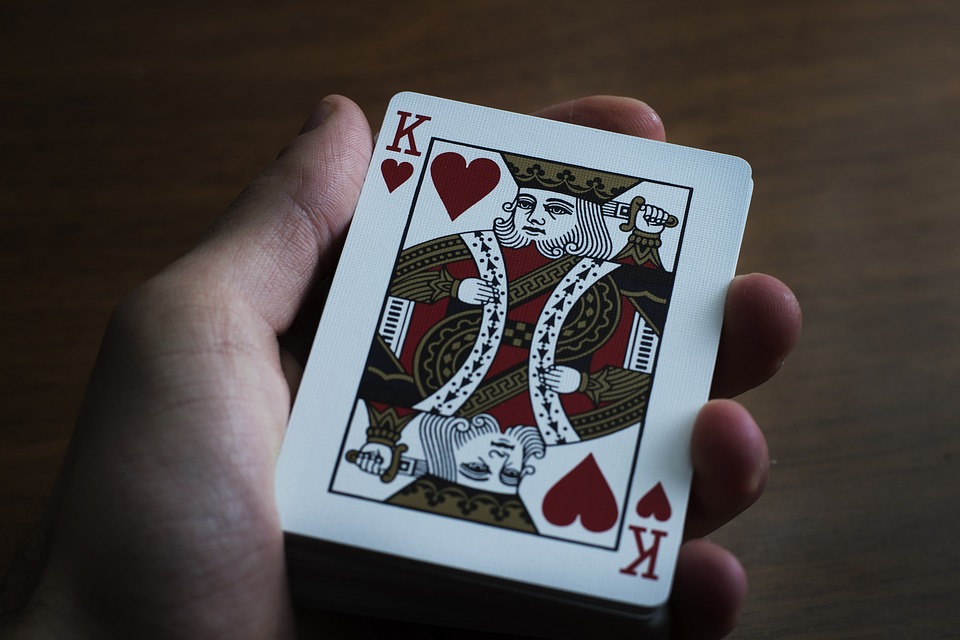Face cards are the cards in a deck that have a picture on them, rather than just a number. There are three face cards in each suit of a standard deck of cards: the jack, queen, and king. Face cards are also known as court cards or royal cards.
This post provides a brief overview of face cards and their importance in card games. It also introduces the topics that will be covered in the rest of the article.
How Many Face Cards are in a Deck?
There are 12 face cards in a standard deck of 52 playing cards. Each of the four suits (clubs, diamonds, hearts, and spades) has three face cards: a jack, a queen, and a king.
Here is a list of all the face cards in a standard deck of cards:
- Jack of clubs
- Queen of clubs
- King of clubs
- Jack of diamonds
- Queen of diamonds
- King of diamonds
- Jack of hearts
- Queen of hearts
- King of hearts
- Jack of spades
- Queen of spades
- King of spades
What are the Rankings of Cards
A standard deck of playing cards contains 52 cards, divided into four suits of 13 cards each: spades, hearts, diamonds, and clubs. The cards in each suit are ranked from ace (highest) to two (lowest). Face cards (jack, queen, and king) are ranked between ten and ace.
Face cards are typically ranked higher than numbered cards, with the ace being the highest-ranking card in the deck. However, the specific ranking of face cards can vary depending on the game being played.
For example, in some games, the jack is ranked higher than the queen, while in other games, the queen is ranked higher than the jack.
Related Post: Is the Sandlot Based on a True Story? (Explained)
Here is a table of the rankings of cards in a standard deck:
| Rank | Card |
- | 1 | Ace |
- | 2 | King |
- | 3 | Queen |
- | 4 | Jack |
- | 5 | 10 |
- | 6 | 9 |
- | 7 | 8 |
- | 8 | 7 |
- | 9 | 6 |
- | 10 | 5 |
- | 11 | 4 |
- | 12 | 3 |
- | 13 | 2 |
Example
Here is an example of how face cards are ranked in a game of poker:
- Ace
- King
- Queen
- Jack
- 10
- 9
- 8
- 7
- 6
- 5
- 4
- 3
- 2
In poker, the ace can be ranked as either the highest or lowest card in the deck, depending on the player’s preference.
History of Playing Cards
The exact origins of playing cards are unknown, but they are thought to have originated in Asia, possibly in China or India, around the 10th century AD. Playing cards were first introduced to Europe in the 14th century, and quickly became popular throughout the continent.
Early playing cards were hand-painted and made of expensive materials, such as ivory or parchment. This made them a luxury item that was only affordable to the wealthy. However, as playing cards became more popular, mass production techniques were developed, making them more affordable for everyone.
Related Post: Why am I Getting so Many Friend Requests on Facebook?
Symbolism of Cards
The four suits in a standard deck of playing cards have a number of symbolic meanings. These meanings are thought to have originated in medieval Europe, and are associated with the four social classes of the time:
- Spades: The spades suit is associated with the military and nobility. The spade symbol is thought to represent a sword or pike.
- Hearts: The hearts suit is associated with the clergy. The heart symbol is thought to represent the chalice or cup used for communion.
- Diamonds: The diamonds suit is associated with the merchant class. The diamond symbol is thought to represent a coin or jewel.
- Clubs: The clubs suit is associated with the peasant class. The club symbol is thought to represent a tree or agricultural tool.
These symbolic meanings are often reflected in the artwork on playing cards. For example, the court cards in many decks are depicted as members of the different social classes.
The king and queen of spades, for example, are often depicted as a knight and princess, while the king and queen of hearts are often depicted as a bishop and queen.
Types of Playing Card Decks
There are many different types of playing card decks used around the world. The most common type of deck is the standard 52-card deck, which is used for playing games such as poker, blackjack, and bridge. However, there are also many other types of decks, such as:
Tarot decks: Tarot decks are 78-card decks that are used for divination and fortune telling. Tarot decks contain a variety of unique cards, such as the Fool, the Magician, and the High Priestess.
Regional decks: Many countries and regions have their own traditional playing card decks. For example, the Spanish deck has 48 cards and uses the suits of swords, cups, coins, and clubs. The German deck has 32 cards and uses the suits of acorns, leaves, hearts, and bells.
Themed decks: There are also many themed playing card decks available, such as decks with Disney characters, sports teams, or works of art.
Related Post: How Long is 60 Days? (Explaining the Calculation Process)
Types Of Playing Card Deck
Playing card decks come in many different varieties, but the most common type is the French-suited deck, which contains 52 cards divided into four suits: clubs (♣), diamonds (♦), hearts (♥), and spades (♠).
Each suit contains 13 cards, ranked from ace (highest) to two (lowest). In addition to the four suits, many French-suited decks also contain one or two jokers, which have no suit or rank.
Other types of playing card decks include:
- German-suited decks: These decks contain 48 cards divided into four suits: bells (♥), acorns (♣), leaves (♠), and hearts (♦). Each suit contains 12 cards, ranked from ace (highest) to six (lowest).
- Swiss-suited decks: These decks contain 36 cards divided into four suits: bells (♥), acorns (♣), roses (♦), and shields (♠). Each suit contains nine cards, ranked from ace (highest) to nine (lowest).
- Spanish-suited decks: These decks contain 48 cards divided into four suits: swords (♠), cups (♥), coins (♦), and clubs (♣). Each suit contains 12 cards, ranked from ace (highest) to seven (lowest).
- Italian-suited decks: These decks contain 40 cards divided into four suits: swords (♠), cups (♥), coins (♦), and batons (♣). Each suit contains 10 cards, ranked from ace (highest) to ten (lowest).
In addition to these traditional decks, there are also many specialized decks designed for specific games or activities. For example, there are tarot decks, which contain 78 cards, including 22 major arcana cards and 56 minor arcana cards. Tarot decks are often used for divination and fortune-telling, but they can also be used for playing games.
There are also many novelty decks available, with designs and themes that range from humorous to educational. For example, there are decks featuring images of animals, cartoons, or historical figures. There are also decks that are designed to teach children about math, science, or other subjects.
No matter what type of playing card deck you choose, there is sure to be a game that you can enjoy with it. Playing cards are a versatile and entertaining way to spend time with friends and family.
Playing cards are a versatile and popular form of entertainment. They can be used to play a wide variety of games, and they can also be used for divination and fortune telling. Playing cards are also a popular collectible item, and there are many rare and valuable decks in existence.
Related Post: What Does KMS Mean on Snapchat?
Face Card Depictions
There are 12 face cards in a standard deck of playing cards:
- Jack (J)
- Queen (Q)
- King (K)
Each suit (Spades, Hearts, Diamonds, and Clubs) has three face cards.
Combination Possibilities
There are many different ways to combine playing cards. Some common examples include:
- Pairs: Two cards of the same rank, such as two aces or two kings.
- Two pairs: Two pairs of different ranks, such as ace-king and queen-jack.
- Three of a kind: Three cards of the same rank, such as three aces or three twos.
- Straight: Five consecutive cards of the same suit, such as 2-3-4-5-6 of clubs.
- Flush: Five cards of the same suit, regardless of rank, such as ace-king-queen-jack-ten of hearts.
- Full house: Three of a kind and a pair, such as three aces and a pair of kings.
- Four of a kind: Four cards of the same rank, such as four aces or four fours.
- Straight flush: Five consecutive cards of the same suit, such as 2-3-4-5-6 of hearts.
- Royal flush: A straight flush of the highest five cards in a suit, such as ten-jack-queen-king-ace of spades.
Playing Card Probability
The probability of drawing a particular card from a standard deck is equal to the number of favorable outcomes divided by the total number of possible outcomes. For example, the probability of drawing an ace is 4/52, or 1/13, since there are 4 aces in a deck and 52 total cards.
The probability of drawing a particular combination of cards is more complex, but it can be calculated using the same basic principle. For example, the probability of drawing a pair of aces is 6/221, or about 2.7%.
Here are some examples of playing card probabilities:
Probability of drawing an ace: 1/13
Probability of drawing a king: 4/52 = 1/13
Probability of drawing a heart: 13/52 = 1/4
Probability of drawing a face card: 12/52 = 3/13
Probability of drawing a pair of aces: 6/221 = about 2.7%
Probability of drawing a straight flush: 4/10,255,596 = about 1 in 2,598,960
Playing card probabilities can be used to calculate the odds of winning various card games. For example, the odds of winning a hand of blackjack are about 48% in the player’s favor.
Related Post: What are Examples of Savory Foods? (25 Examples)
What is the possibility you pick two aces in a row?
There are 4 aces in a standard deck of 52 cards. The probability of picking one ace is 4/52 = 1/13.
If you replace the first card before picking the second card, then the probability of picking two aces in a row is 1/13 * 1/13 = 1/169.
However, if you do not replace the first card, then the probability of picking two aces in a row is lower. This is because there are now only 3 aces left in the deck after you pick the first ace. So, the probability of picking a second ace is 3/51.
Therefore, the probability of picking two aces in a row without replacement is 1/13 * 3/51 = 1/221.
Which probability you are interested in depends on the specific scenario. For example, if you are playing a game of cards where the cards are replaced after each draw, then the probability of picking two aces in a row is 1/169.
But if you are dealing cards to yourself from a deck that you are not replacing the cards from, then the probability of picking two aces in a row is 1/221.
Related Post: How Many Weeks Until Halloween (Countdown Timer and Updates)?
Conclusion
Face cards are an important part of many card games. They can add excitement and strategy to the game, and they can also be used to create winning hands.
FAQs
There are three different types of face cards: jacks, queens, and kings.
The most valuable face cards are the king and queen.
Face cards are often used in special combinations in card games, such as two-pair, three-of-a-kind, and four-of-a-kind.
References
- school.careers360.com/how-many-face-cards-are-in-deck
- thecoldwire.com/how-many-face-cards-are-in-a-deck/






